Haven’t really been able to post anything recently, but I took a few pictures of different places where I had some tea…




No, I didn’t add sugar.

Haven’t really been able to post anything recently, but I took a few pictures of different places where I had some tea…




No, I didn’t add sugar.
Categories: Misc · Old Xanga posts · Teas
Tagged: travel
Longjing is my first love. I’ve talked about longjing a long time ago. It was the tea that got me into tea drinking. It’s the tea that my grandpa likes to drink a lot (yes, in grandpa style), and it’s also the drink of choice for folks from my area of the country. All this oolong stuff is just silly, and puerh is obviously crap. Longjing (and maybe biluochun) are the gold standards of what constitutes a proper tea.
I used to be pretty serious when brewing longjing — gaiwan with a fairness cup to cool the water, a soft pour, quick(ish) steeps. The resulting brew comes out very, very light in colour. The best longjing, as my old post already mentions, are usually very faint in colour — almost white, rather than green, is the norm. If your leaves are dark green and the tea comes out yellow, it’s probably harvested later or low grade stuff. If someone sells you a mingqian (pre-Ming) longjing for $400 a pound and it’s the colour of pine needles, it’s no good.
Another physical trait of decent longjing is that they tend to be hairy, and the buds should ideally be very thick and round. They should look “fat”. If the leaves look “skinny” to you, it’s probably not a very good grade, although of course individuals differ, and the ultimate test is still in the taste. Using appearances to judge tea is a very flawed way to do so, but for something like longjing it is actually possible to get some idea of what the tea is like before even trying it.
I don’t drink much longjing these days, mostly because they tend to be expensive, and I don’t drink much of them to warrant a purchase. Every year I might drink it a handful of times, and the rest, unfortunately, turn to yellow tea, old, somewhat weird tasting, but still drinkable. They are hardly worth the cost, however. Not being near the source also doesn’t help — longjing is something you need to purchase in person, rather than from some online vendor. Being in the US hasn’t helped my longjing habit.
I did receive a sample recently from Toki, however, so I broke it out and gave it a spin. It was a generous sample, so I didn’t use all of it. First off, the leaves
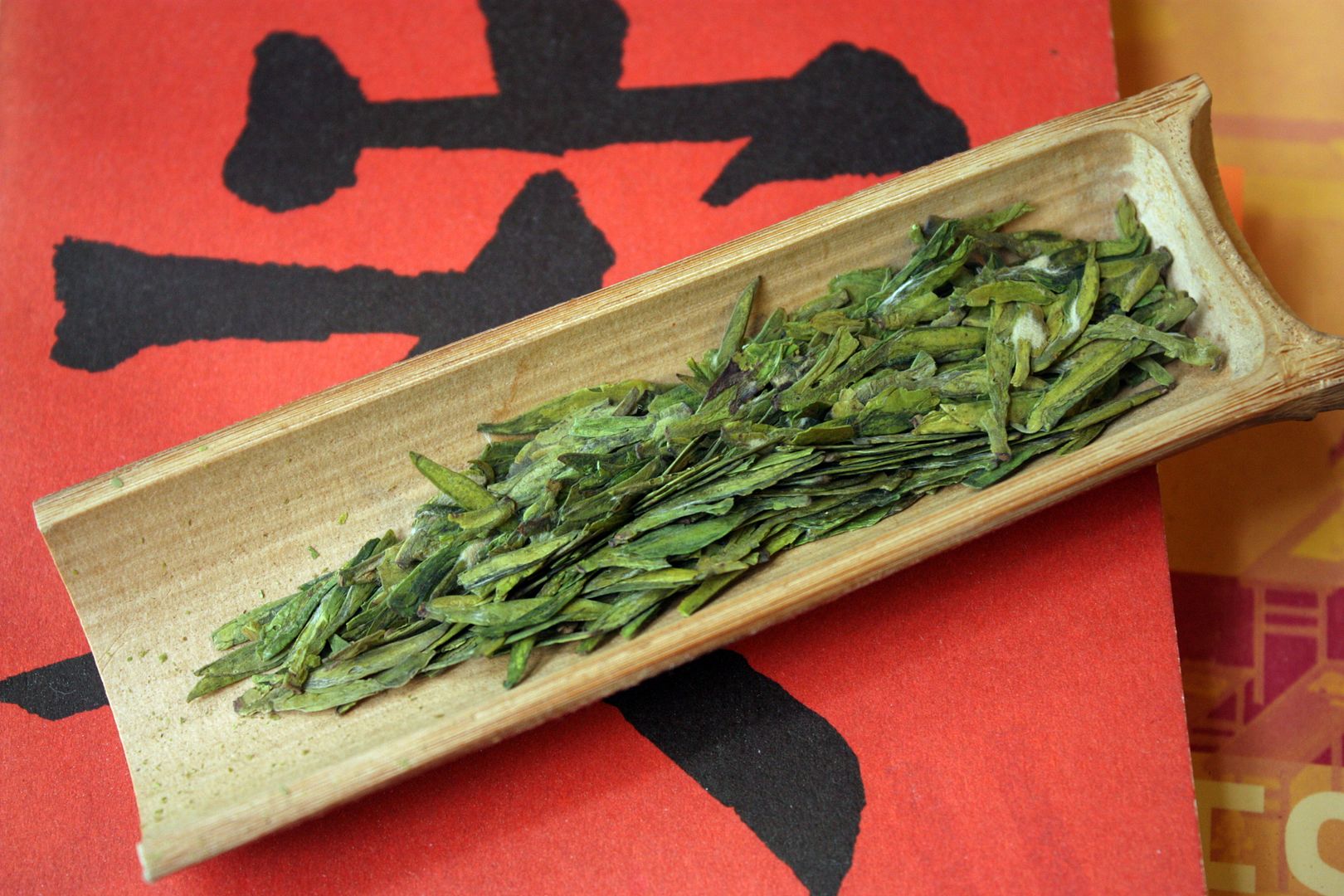
The colours here are a little off — my house has poor lightning for pictures, which is why these days I don’t take as many pictures. You can see the white tuffs of hair on the right hand side on one of the leaves, and scattered around. Different longjing from different vendors always look different.
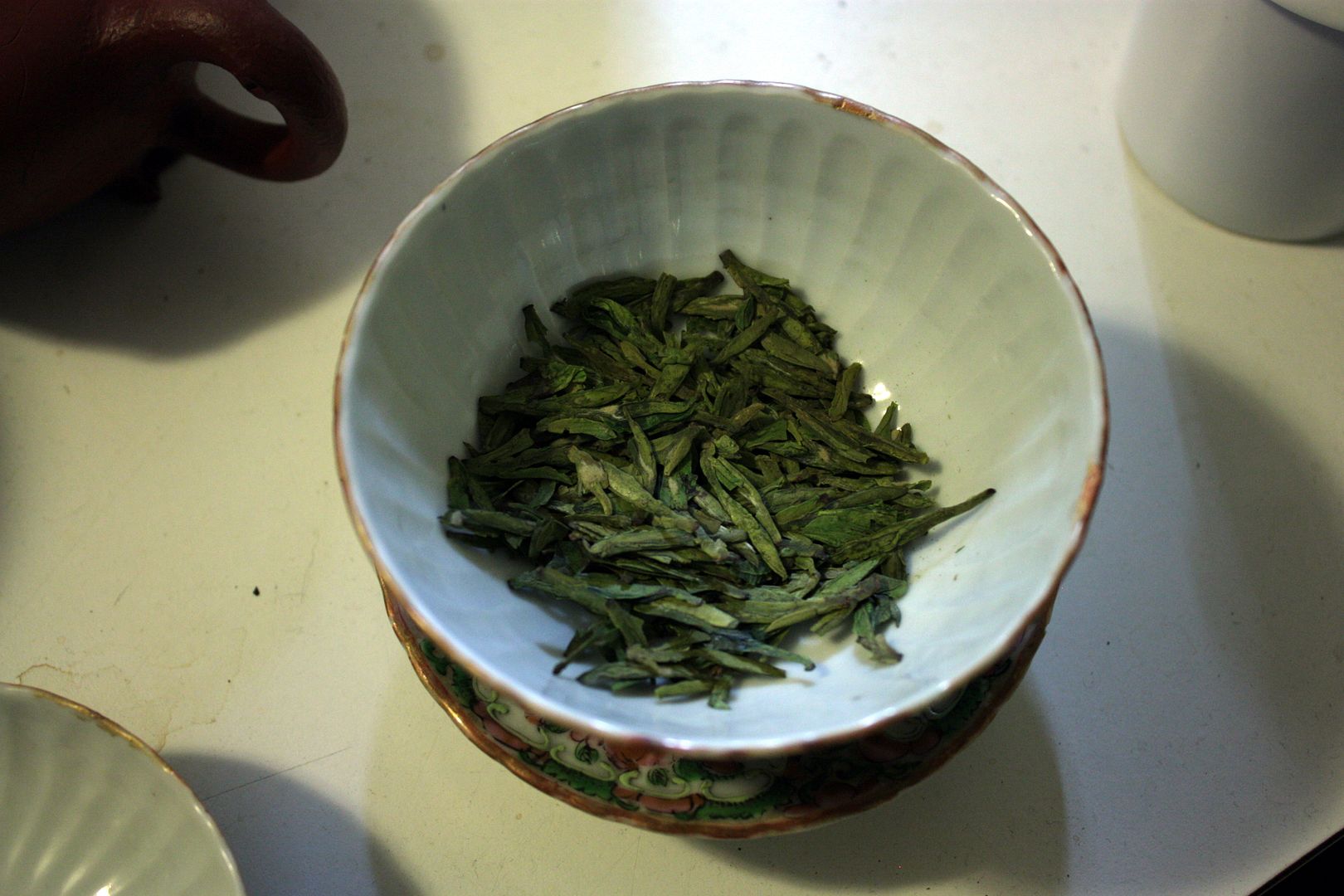
These days when I make longjing, I generally use a gaiwan and make it the old fashioned way — in the gaiwan as a sipping cup. If that’s how people used to make it for hundreds of years, then I see no reason why we should go all fancy on it. It is, in other words, grandpa style with gaiwan.
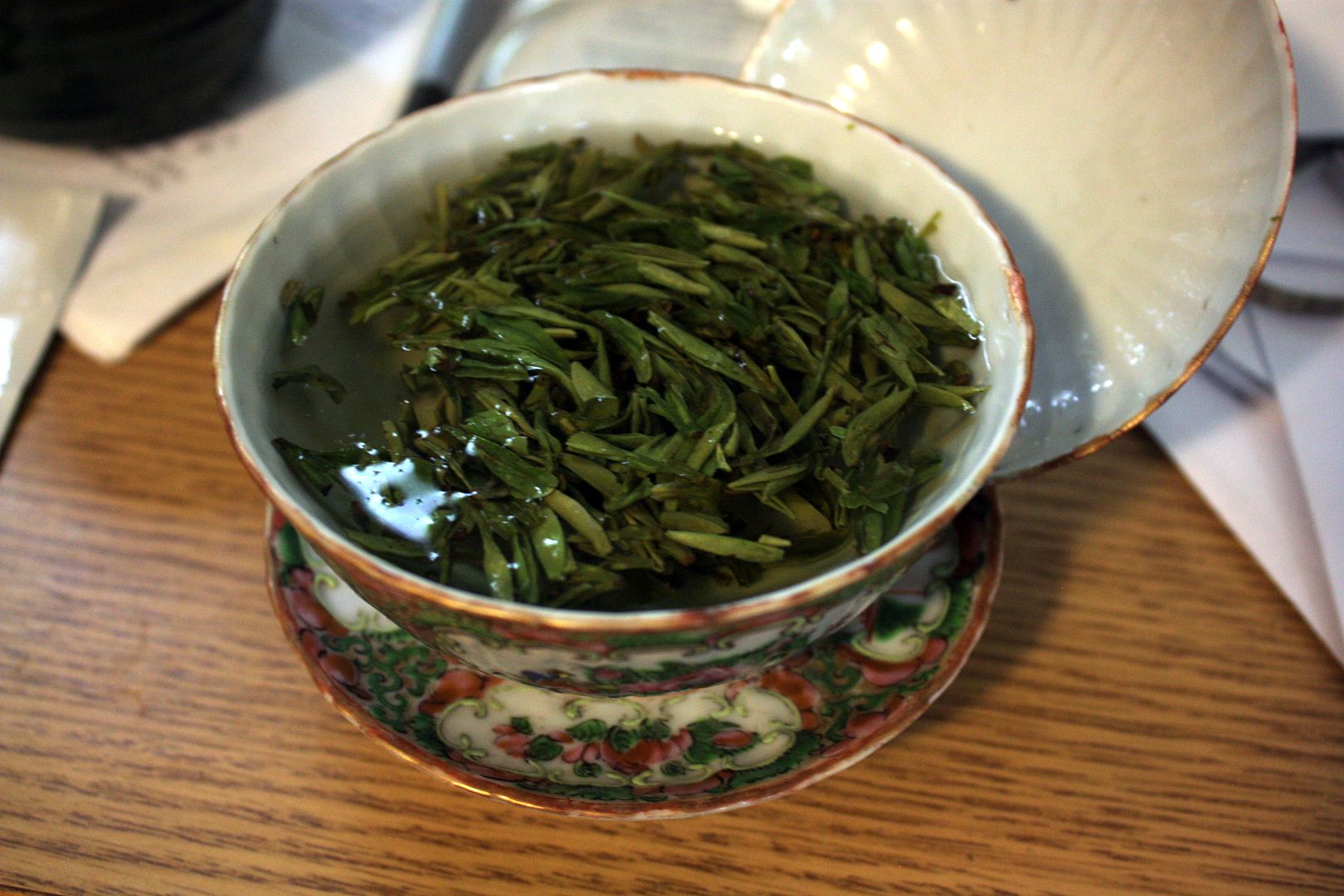
How much leaves to put into these things is key — too much and you risk stuffing the cup and making it incredibly nasty. Too little, and it’s going to be bland. For this sort of brewing, if it covers the bottom of the cup it’s probably about right.
Now, how’s the tea? Fragrant, with a nice minty feel down the throat. I find it to be beany, which is normal for this kind of longjing. It’s not too astringent even when brewed for a while — which is a good thing. I’ll probably make it once the gongfu way, but drunk this way the tea is quite nice.
Categories: Old Xanga posts · Teas
Tagged: friends, grandpa, green tea
I made an order recently through Taobao, and one of the cakes I got was this
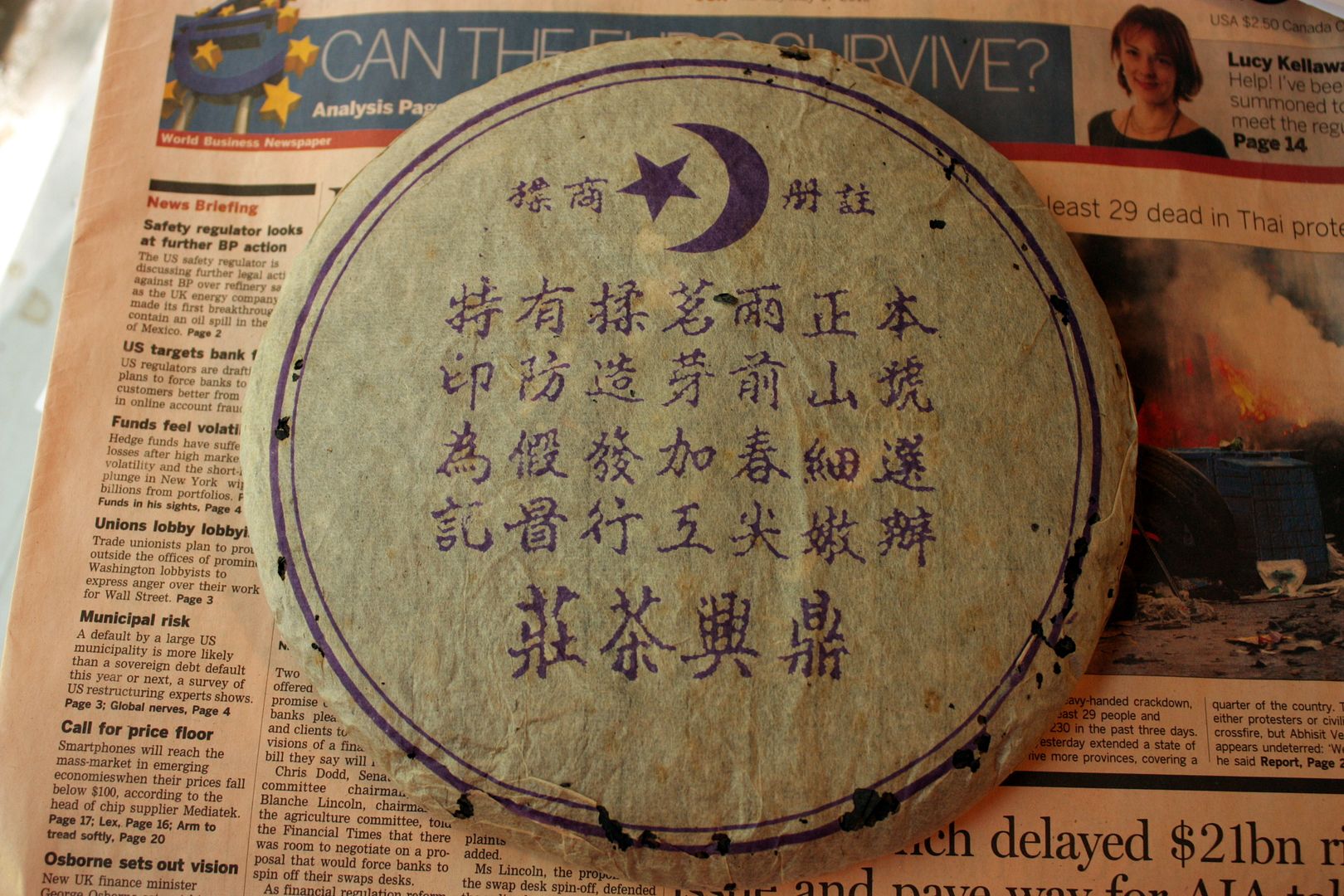
A tea made by “Dingxing”, a long defunct tea maker from early this century. Like many others at the time, some manufacturer saw it fit to use these old school names when making their own puerh. There’s no clear vintage for this tea — I’m guessing around 10 years or thereabouts, plus or minus a few. In some ways, that matters less than what it tastes like — as storage condition matter greatly, and as anyone can tell you, 10 years in Kunming is not the same as 10 years in Hong Kong.
You can see the paper is slightly worn and probably devoured by some bugs. There are no obvious bugs in the cake, but there’s that smell of a wet storage room. The cake itself isn’t really frosted

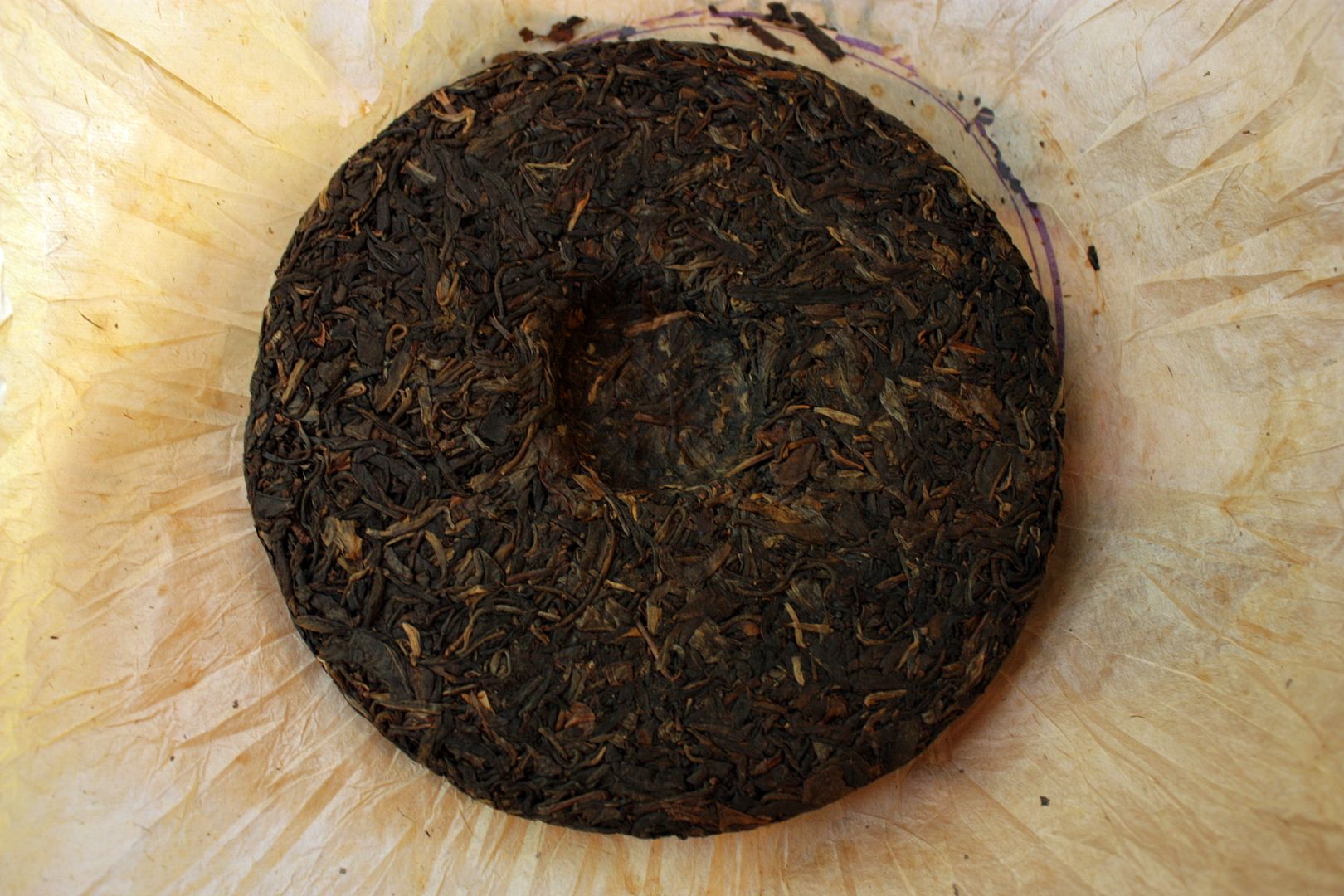

I didn’t use too much leaves. The first two infusions there’s a distinct smell of wet storage, but in a slightly bad way. The cake can use a little time to air out before another attempt. The wet storage, however, goes away a bit, and what remains after the first few infusions is a nice, somewhat aged cup of tea. It’s sweet, although some bitterness remain if you brew it longer. Perfume smells.

And the wet leaves tell the rest of the story.

There are lots of duds on taobao, and I’ve bought a few. This one is not too bad though.
Categories: Old Xanga posts · Teas
Tagged: aged puerh
This is a long, long forgotten sample from YSLLC that I obtained at least a year ago, if not more. It’s no longer available, as far as I can tell. The thing is a brick, so the leaves are, predictably, chopped to high heavens. The general rule of thumb, at least until the past few years, is that anything other than cakes and you’re going to get chopped up leaves. In fact, you’d be better off with tuos than you are with bricks. Bricks is usually a good guarantee for really, really broken stuff.
The tea is interesting — it is aged somewhat, but since it was probably stuck in Kunming, the aging is not very great. The tea is sour, at least in the middle infusions. Strength is low. There wasn’t much to the tea and what it had, it delivered pretty quickly. There’s a reason bricks are not a good investment and why my friends in Hong Kong avoid them.
It’s not horrid — if you can get past the sourness — but it’s not something you’d really rejoice in drinking either. There are better teas out there that are younger but more rewarding. This is not a good example of a 12 years old tea.
Categories: Old Xanga posts · Teas
Tagged: aged puerh, young puerh
Puerhshop’s Jim came out with the “Meiguo Hao”, or “American Hao”, a few years ago. I’ve had this cake for over a year now, but have yet to open it for a tasting. I did just that this week, twice, in fact.
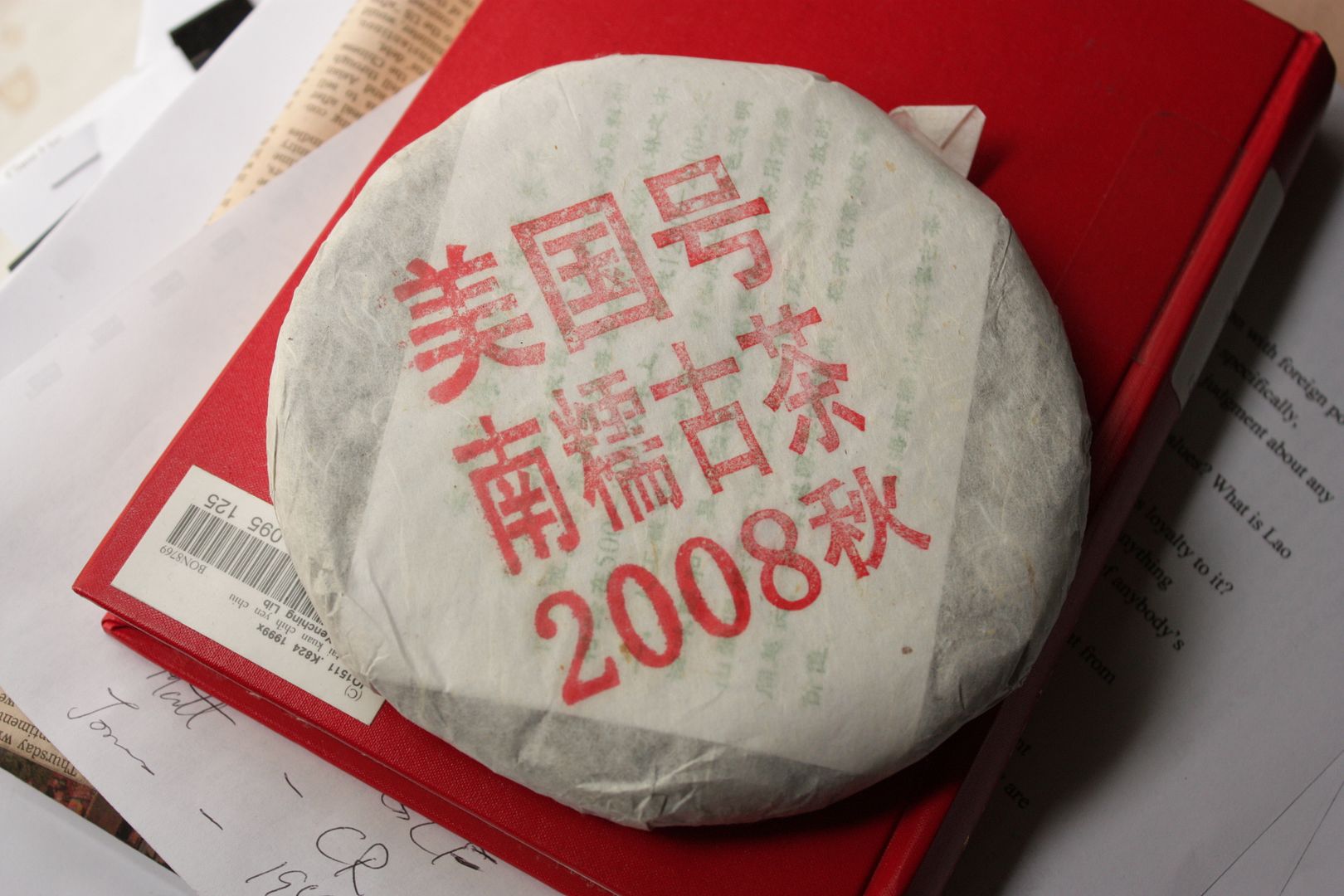
The cake I bought was the 802 production, from fall 2008, and is of the 200g variety. Not much decoration on the wrapper on this one, one of the earliest runs for his cakes. His newer products have fancier packaging.
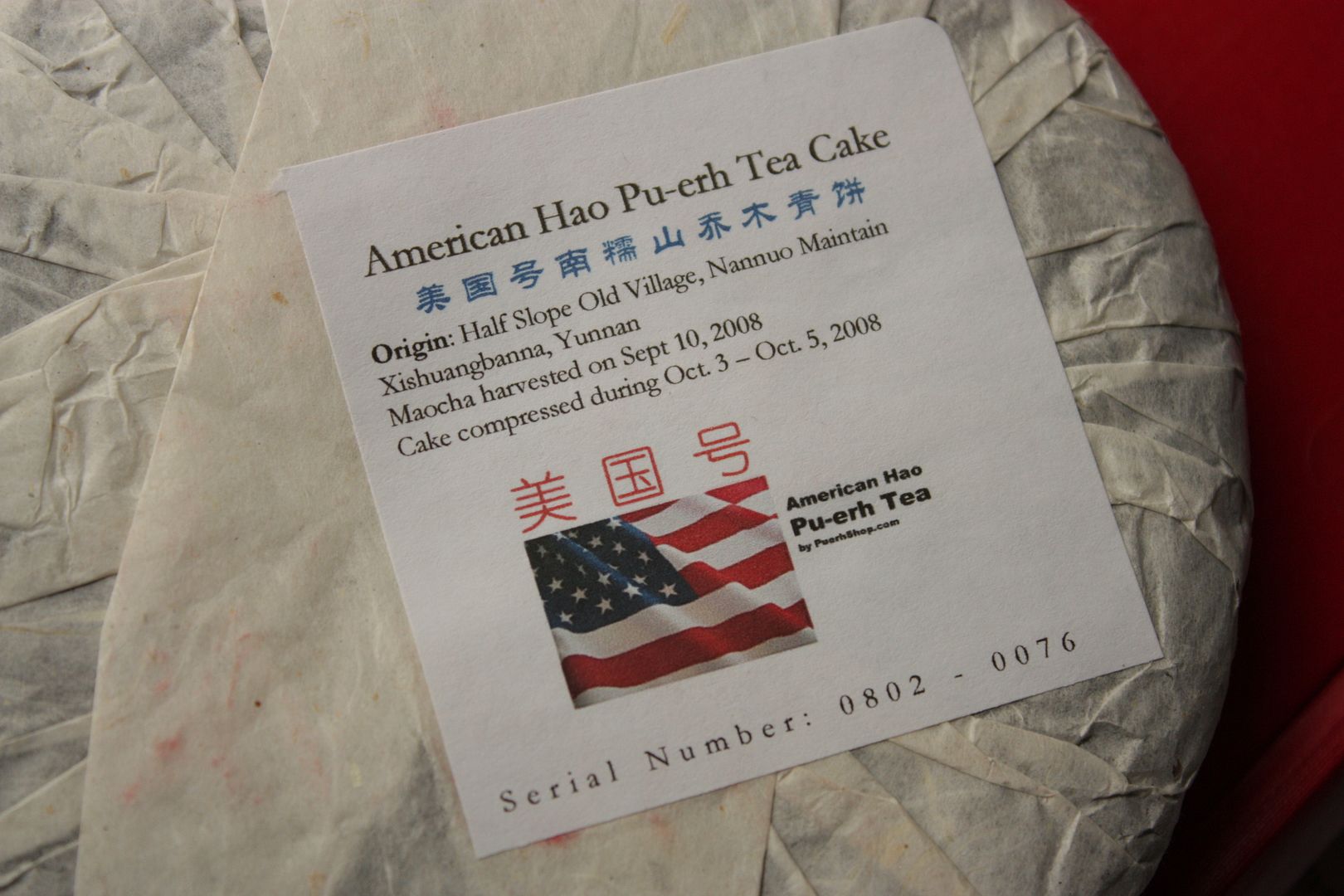
There’s a sticker on the back too keeping the wrapper together with a nice stars and stripes, and a serial number for the cake. BBB reviewed this cake a while ago, and seemed to have liked it. It’s important to note that “Half Slope Old Village” is banpo laozhai — the same place where the Sanhetang maocha came from.
I’ll tell you what I don’t like though — when you open the wrapper, the sticker is too strong. It tears the paper apart even though I unwrapped it fairly carefully, ensuring that I can’t wrap the cake back properly without losing some tea or messing it up.
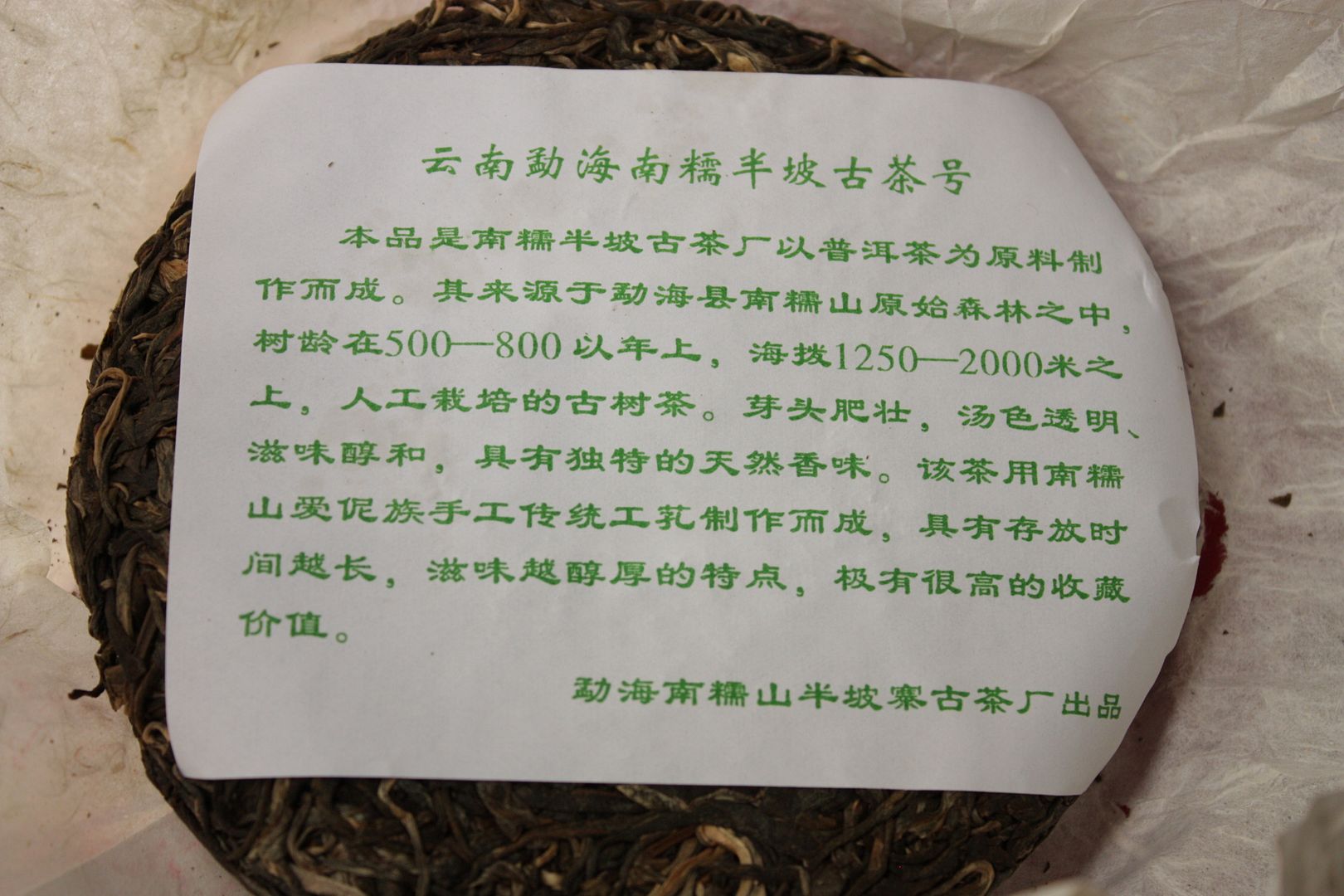
Blah blah blah cures cancer blah blah 10,000,000 years old tree blah blah will be worth a zillion dollars…… made by “Menghai Nannuo Mountain Banpo Zhai Old Tea Factory”. No, it doesn’t actually say it cures cancer, it does say it’s from trees that are 500-800 years old or above, at elevations between 1250-2000m. Take it for what it’s worth.
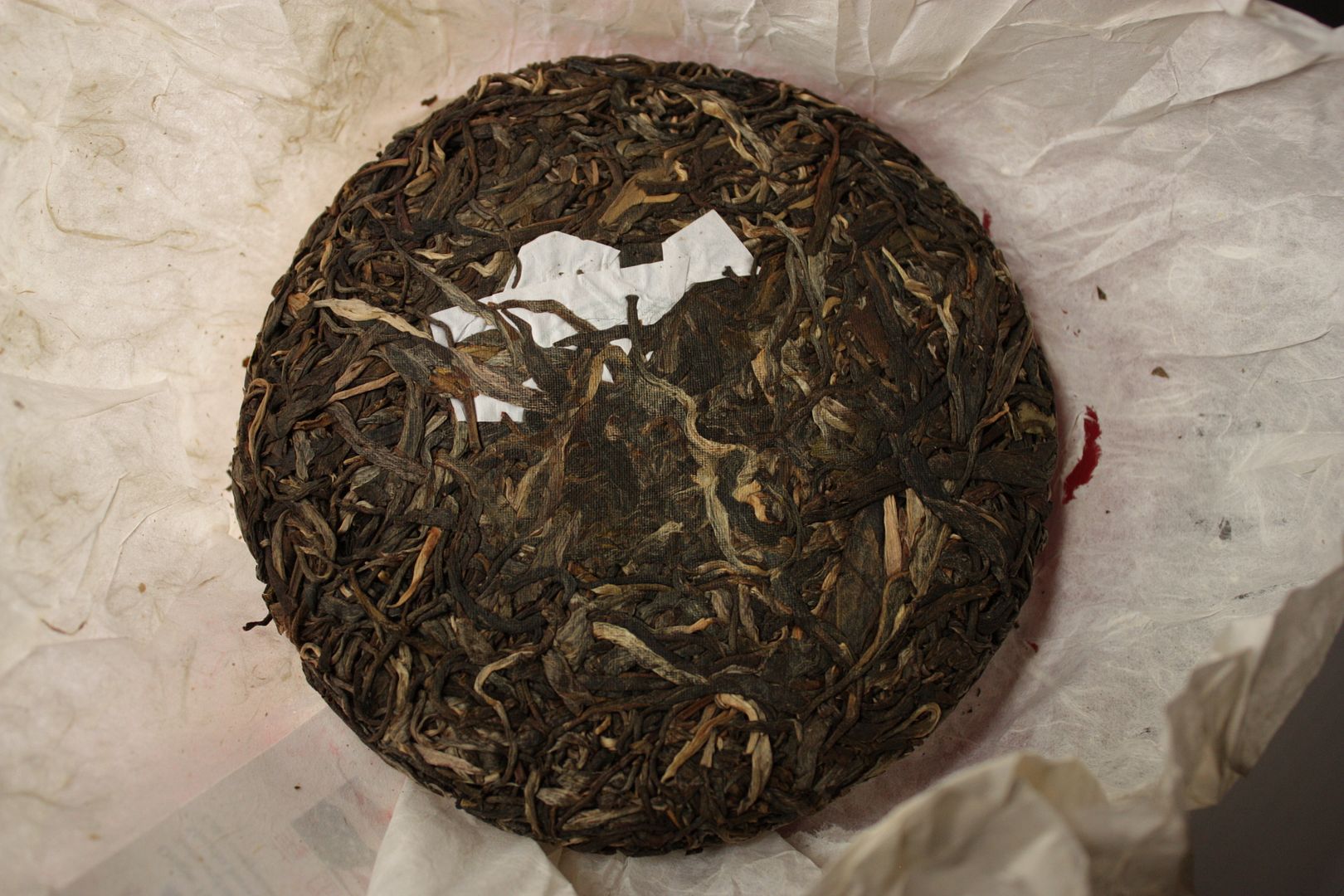
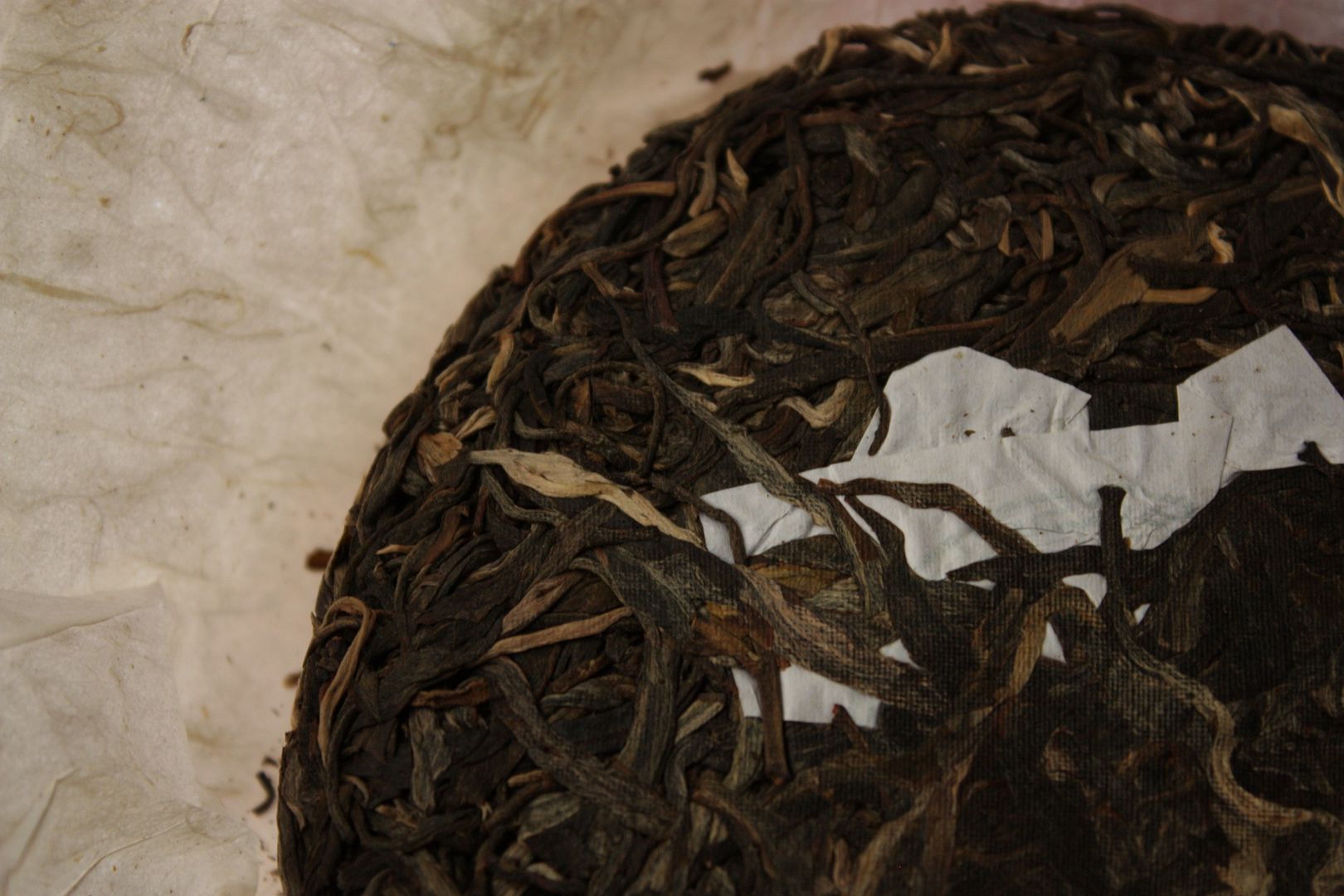
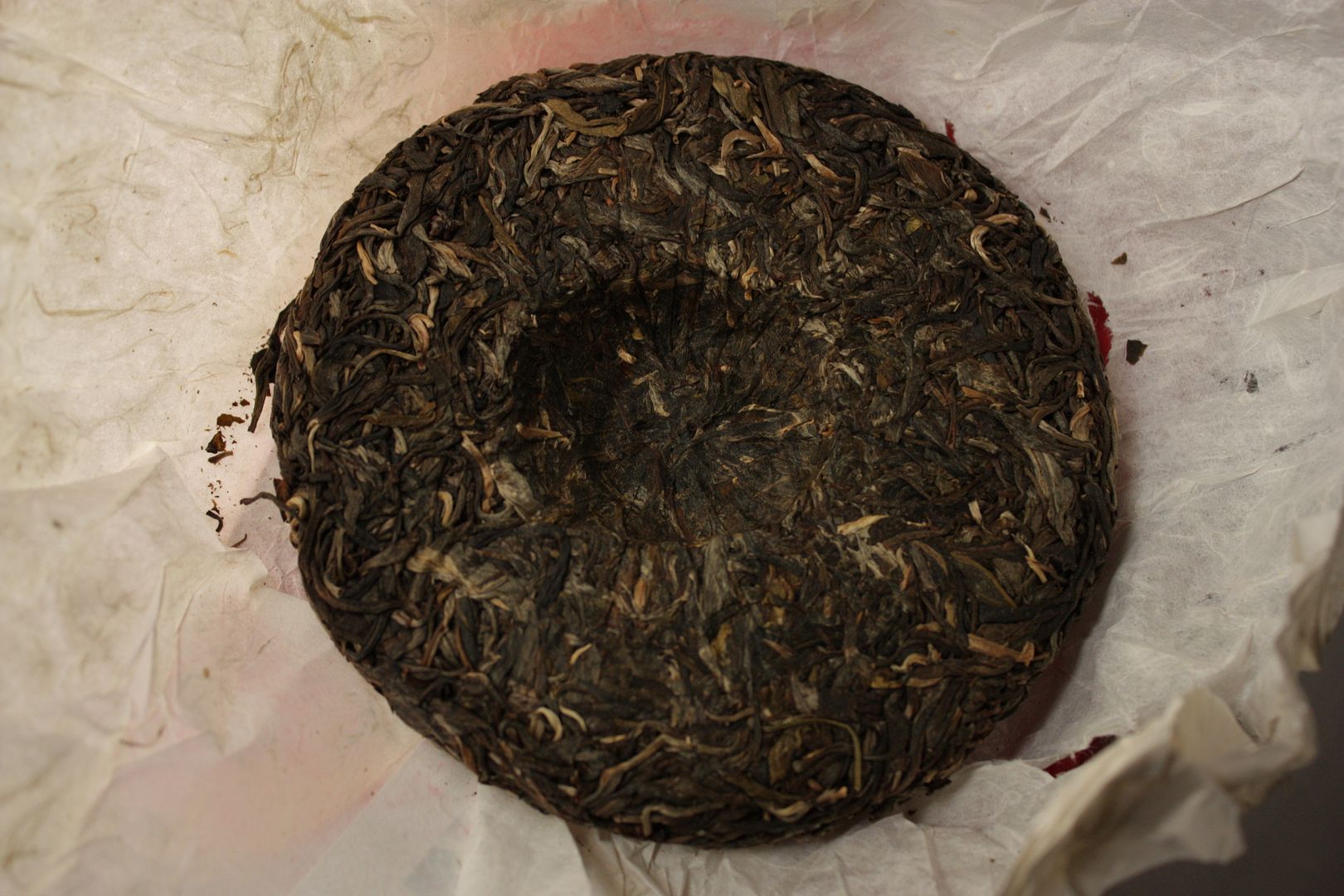
The leaves look nice enough, nothing too old, nothing with too much stem. The cake is not terribly tightly compressed, and a few stabs with a tuocha pick does the job pretty well.
Enough with physical appearances. How’s the tea?
Good. Compared to the Sanhetang stuff, this actually tastes like puerh, although it retains its regionality and you can get that Nannuo taste from it (of which, I might add, I’m generally not a fan). The tea is not too bitter, but it has that bitter note to it, especially when I brewed it a little stronger the second time around. It’s a little on the thin side though, perhaps a product of it being a fall tea, and so it lacks a little of that fullness that I look to find in good, young puerh. Given the price, however, one can hardly complain.
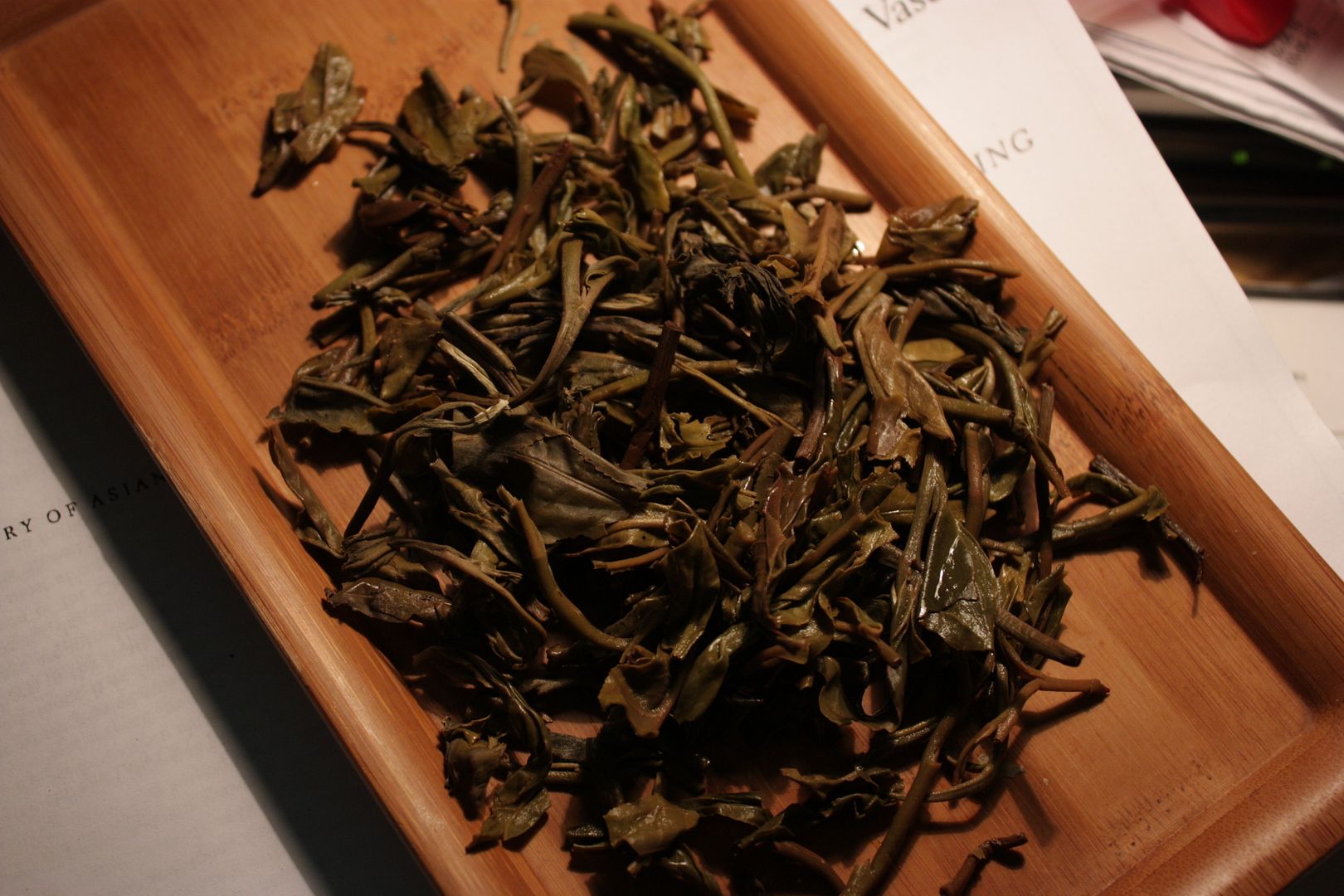
Categories: Old Xanga posts · Teas
Tagged: young puerh
This is the stuff that, long time ago, Hou De used to carry. It’s a nannuo area maocha, supposedly leftover from production. Guang was quite fond of giving them away as an extra, and I got my share when I bought a few small things from him.
It’s been at least three years since I last drank it. I can’t quite find my notes from Beijing, but here’s something from 2006. Funny enough, I remember this tea quite well, because I’ve had it a few times now, and interestingly enough, every time I’ve had it, it tastes the same. Fragrant, straw colour, tastes more like an oolong than a puerh, and even though it’s been a good four years since I first got it — my impression of the tea is almost exactly the same. No real change going on here.
This compares with some of the other maocha I bought since then, for example one I got from Beijing, which has aged some since my purchase in 2006 and in fact provides a good study in comparative change. I’ve always suspected these Nannuo maocha from Sanhetang were processed badly — killed green, which means it won’t age. The leaves, as I’m staring at them right now, are bright green. I don’t think it’s a good puerh candidate for aging.
At least this is the last I’ll see of it — it’s the final bits in my bag. So long, Banpo laozhai.
Categories: Old Xanga posts · Teas
Tagged: young puerh
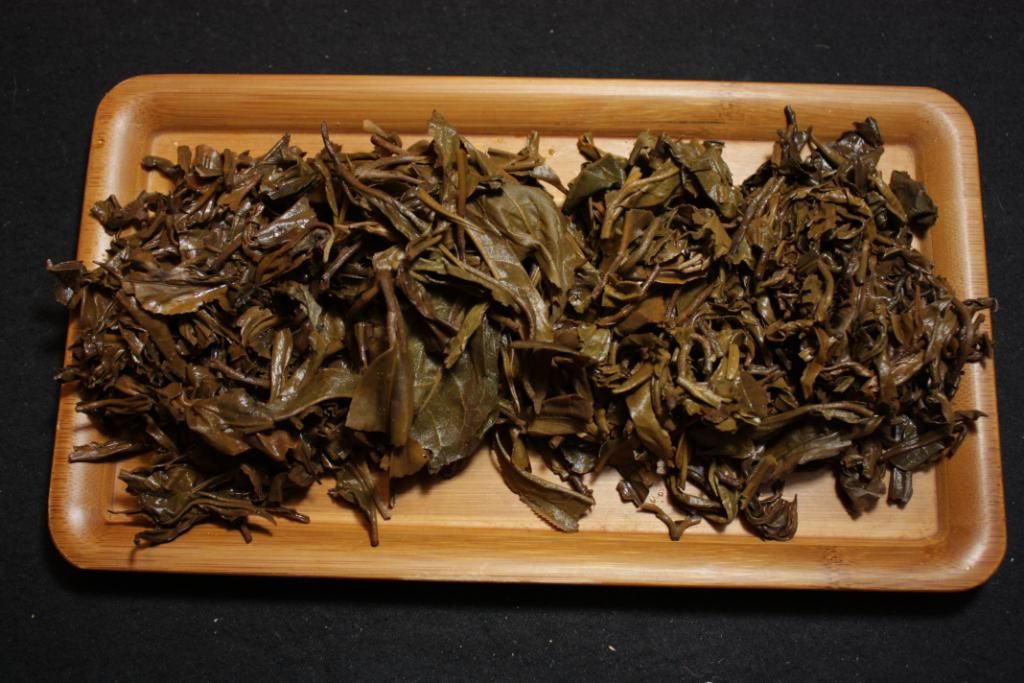
If you look carefully, there are four teas here. From left to right
1) My 2003 Bulang that I love a lot. This tea is mostly buds — very small leaves, young, and fresh. I think the reason why the tea is so punchy in terms of caffeine is because of the heavy proportion of buds in the leaves. You can probably tell from the wet leaves that they are small, especially in comparison to….
2) A 2005 Manzhuan which is no longer available anywhere, not even Taobao. I like Manzhuan teas. Large leafed, but not old. Very few “woody” stems in the cake, which is supposedly a good thing. I like this cake a lot, and I think aging wise, it has real potential. I can’t say that about…
3) A 12 Gentlemen Jinggu from 2006. I’ve never liked Jinggu teas, thinking that they are poor candidates for aging, and this basically confirms that suspicion — the tea was thin, bland, and gave me a stomach ache for some reason. It didn’t go down well at all, and I dumped it after a few infusions. 12 Gentlemen’s makers got some publicity back when they first started in 2006, and although I was never impressed enough with them to buy anything (other than a few samples, of which this is one) their other offerings were at least better than this. There’s probably a reason why, after the explosion of young puerh a few years ago, you no longer see Jinggu teas showing up very much these days.
4) The last is a sample from Lew of babelcarp that I have kept for a few years now. It’s from the 101 Plantation (not sure if they still sell tea). The tea was quite expensive back then. I used the remaining sample, and am happy to report that the tea is actually holding up quite well. It’s got good body and flavour, and should continue to evolve over time. Lew, how are the cakes doing?
Categories: Old Xanga posts · Teas
Tagged: young puerh
I was in Philly the past weekend for a conference, and for much of the time I was there I spent in the hotel or in Chinatown, which was right next to it. Normally I’d bring my own tea to things like this, so I don’t have to endure bad teabags with coffee-flavoured water (when will these places ever learn????). However….. I forgot to bring my own stash this time.
So…. I was out of tea, and I don’t want to drink that nasty, nasty stuff brewed with coffee water. What do I do?
Chinatown
Many of you live near a Chinatown or another, and no doubt some have visited these institutions before. I still remember when I lived near Cleveland that they had nothing but Foojoy tea and a few other horrible abominations that could pass for “tea”, but at the same time, I also remember that the first revelation I had in tea came from a longjing that I bought at the now defunct Great Wall in NYC’s Chinatown.
I ducked into an underground market in Philly’s Chinatown, and walked into their tea aisle. It’s quite well stocked.
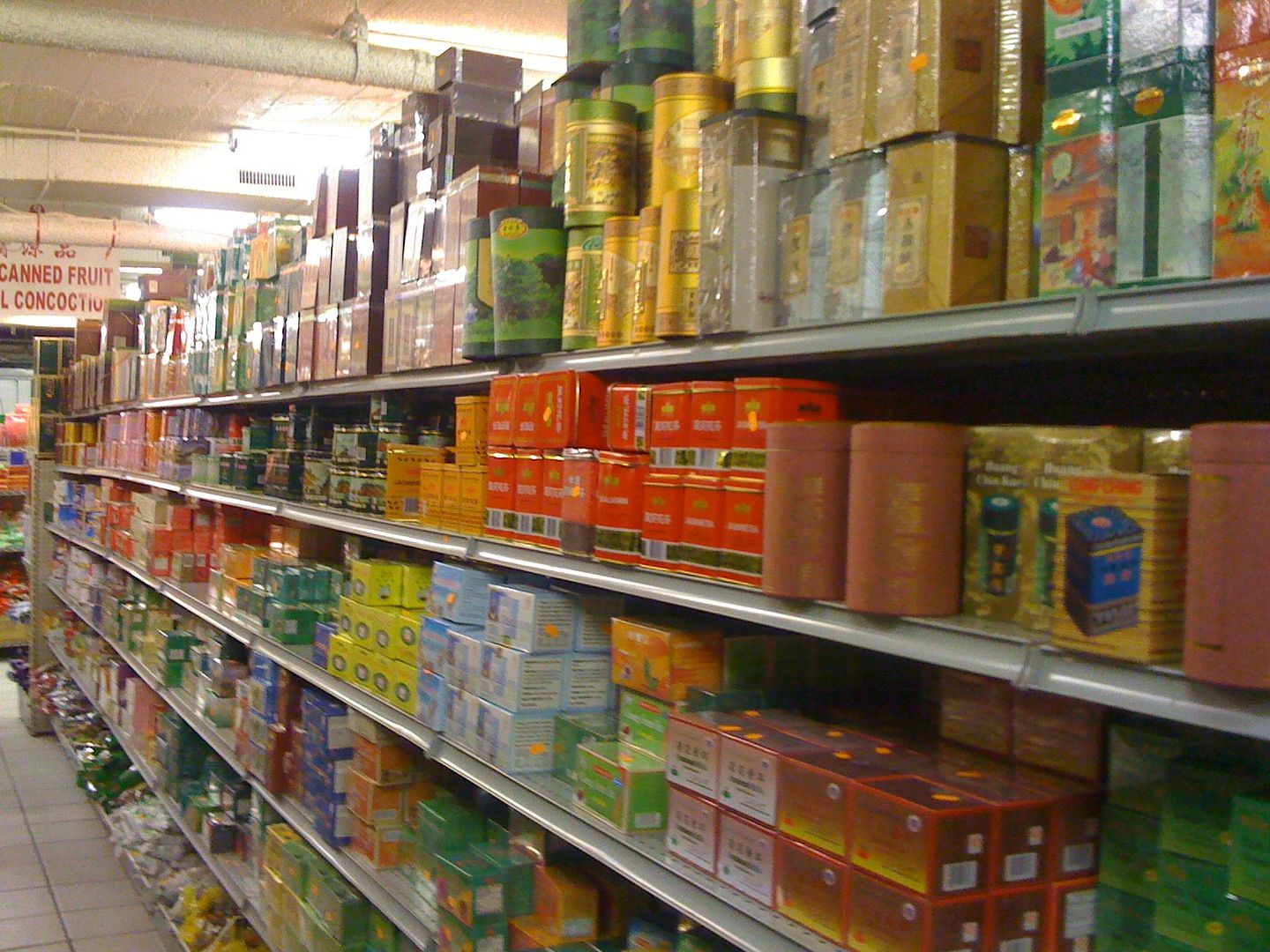
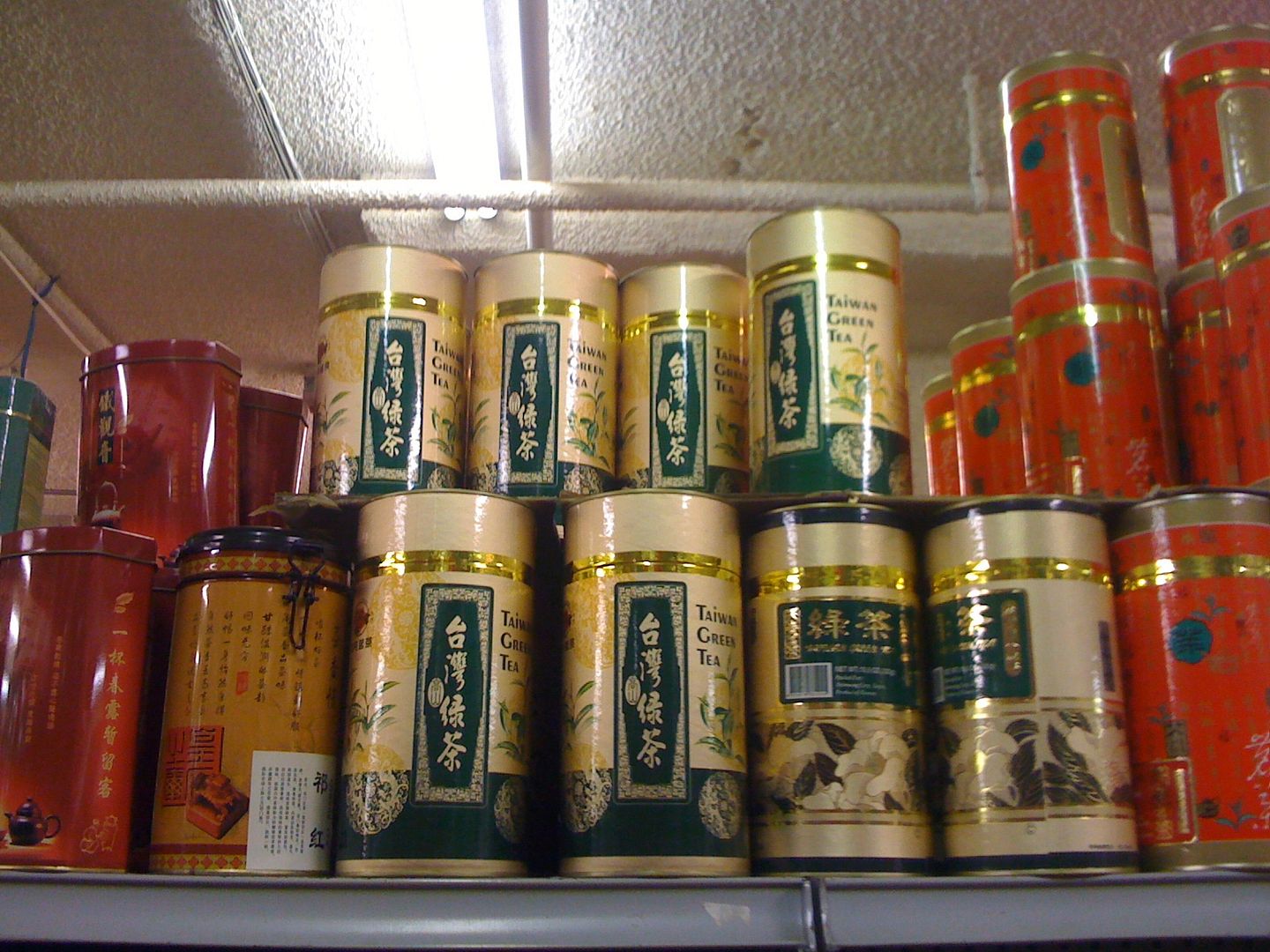
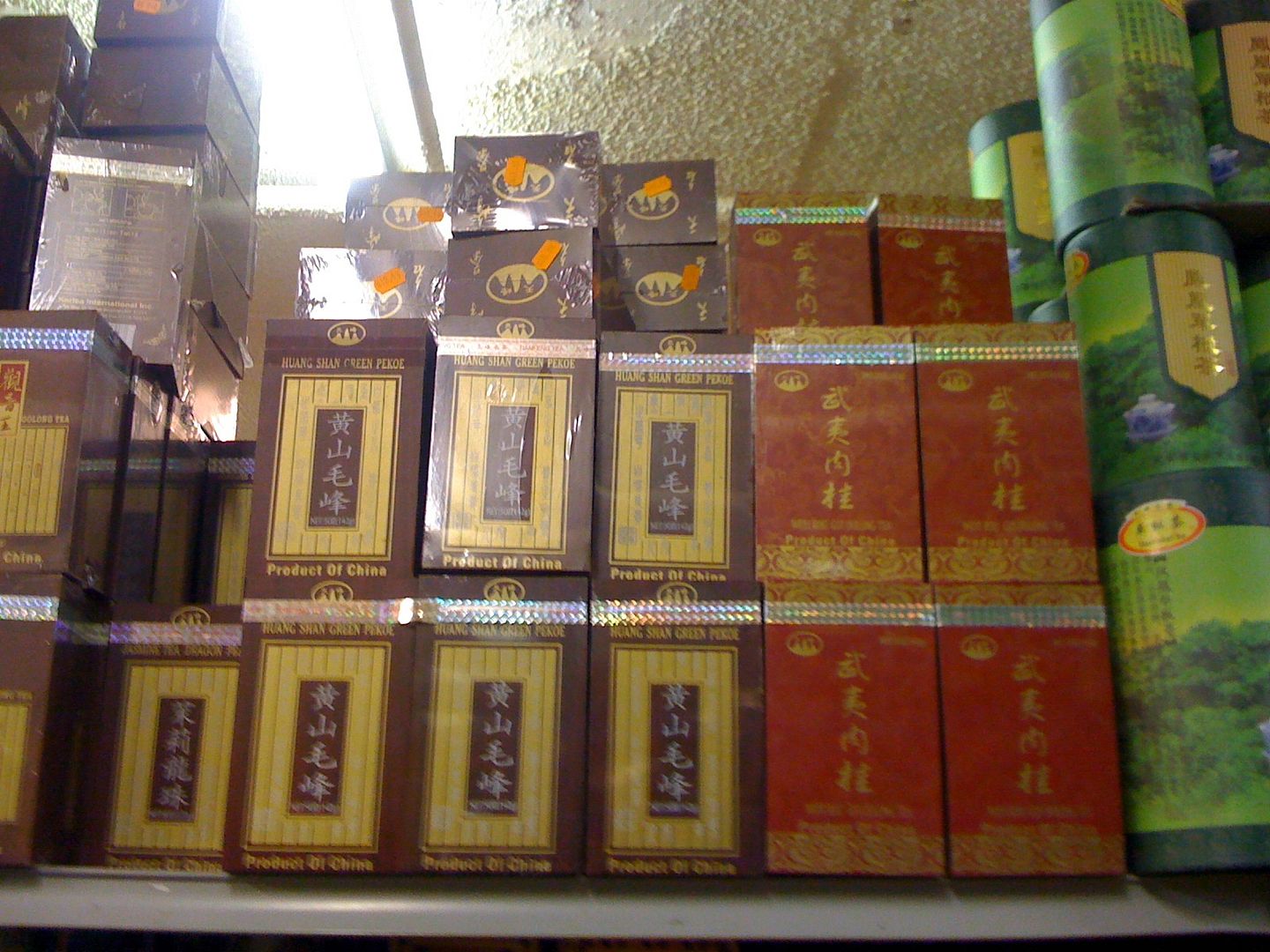
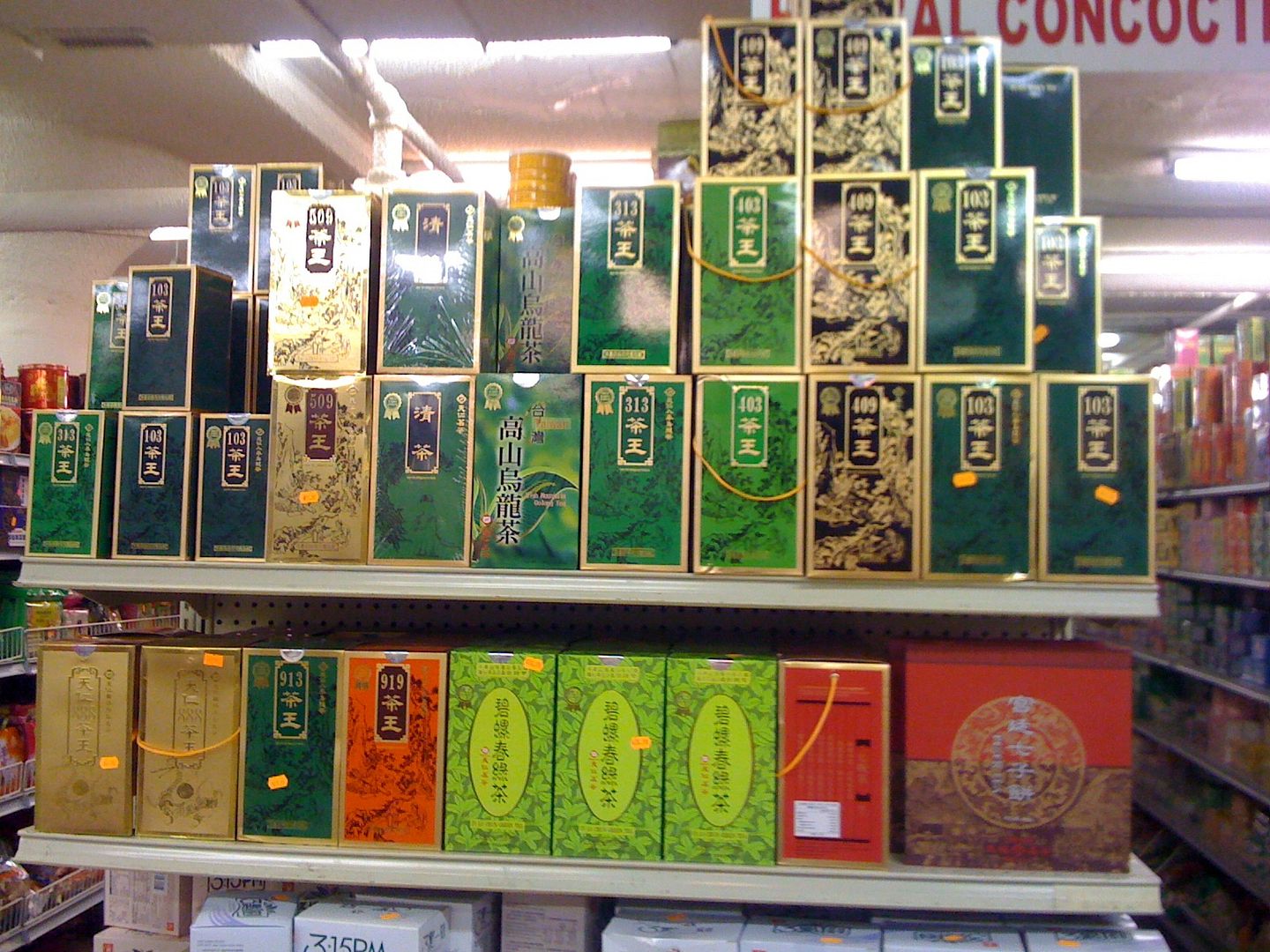
It’s actually extremely difficult to buy any of this stuff with any confidence, because you know that for the most part, they’re not particularly great, and since there’s no way for you to look at the leaves or taste it first, you’re really taking a gamble. Over the years the type of tea that they sell have been upgraded, at least in terms of packaging. Instead of the ugly little tins for the old style, CNNP brands, now you have all kinds of Taiwanese and Mainland producers who vie for your attention.
I was, at first, attracted to a tin of Keemun, thinking that you can hardly go wrong — even the worst Keemun can be pretty ok, with inferior water and what not. Then, however, I chanced upon a tin of puerh — specifically, one that is labeled “Nuoshan pu’er cha”. Nuo, in this case, is Nannuo’s nuo. It reminded me of the Nor-sun that I bought a few years ago in Columbus and which turned out to be quite all right. I took a chance and bought this, $3.98 a tin tea.
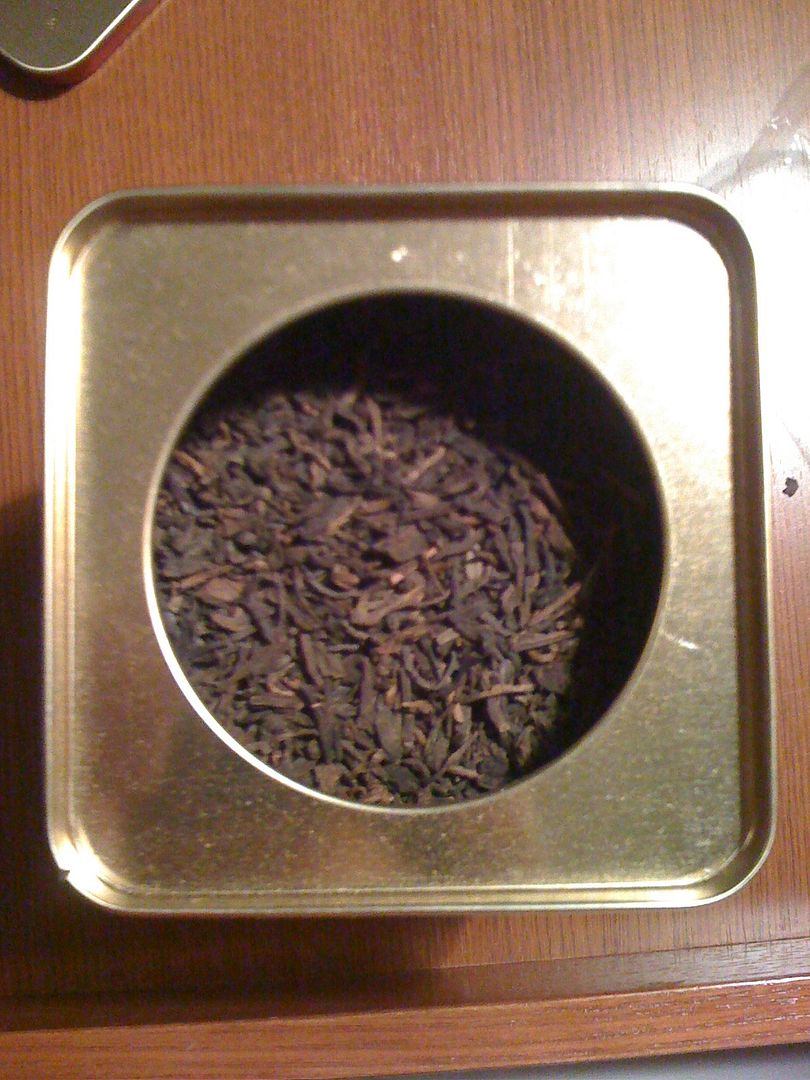
The first thing I noticed when I opened the tin is that it smells — it has this odd medicinal smell that is somehow slightly citrus like. The leaves are very broken, as you can see. When I tried it out, it brewed a dark, dark liquor. It does not, however, have that fishy, pondy cooked tea taste, but it’s definitely cooked (mostly, anyway). Once you get rid of that odd citrus smell, which disappears quite quickly, the tea is remarkably decent. At the very least, it probably beats all these loose puerh that online stores like Adagio sell at a much higher price.
I tried it again yesterday, now that I’m back at home. You can taste the odd citrus flavour the first infusion or two, and then it goes away. The tea is soft and smooth, and actually delivers that nice, plummy taste in the later infusions when brewed longer.  Definitely a winner for $3.98.
Moral of the story? Try your local Chinatown, if there’s a sizable one next to you. You never know what you might find.
Categories: Old Xanga posts · Teas
Tagged: cooked puerh, shopping
I’m actually going to talk about a tea that I drank. When’s the last time I did that?
Among the teas I bought from Taobao recently is a cake from a producer that I knew from back in 2006. They made some nice Yiwu, and I’ve always been on the lookout for them. According to things I’ve found online, they are located about 100m from the Sanhetang workshop in one of the Yiwu villages, and the cake I bought off Taobao (since soldout — thanks to me) is a Manzhuan cake. I happen to like Manzhuan cakes a lot — more depth than Yiwu sometimes, and less watery. There’s also less faking going on.
The leaves are fairly good looking

And the tea brews a darkish colour, for something that’s from 2005.
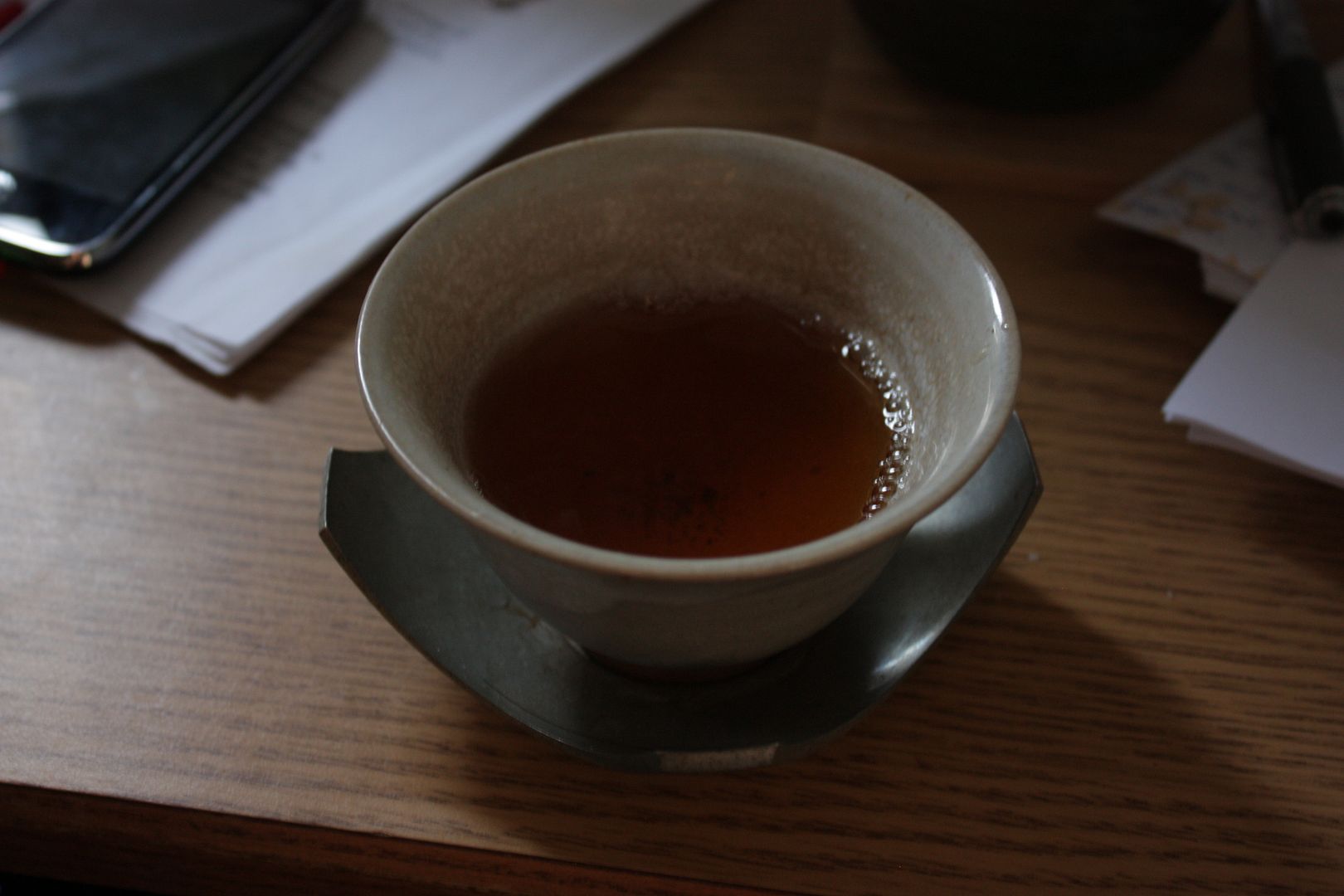
It’s got some sour notes early on, which I think is 1) fairly typical of some Manzhuan teas and 2) also a characteristics of a 4-5 year old tea, again depending on storage conditions, etc. It has that nice, deep, lingering sensation at the back of the mouth that I love from my younger pu, and a sweetness that comes through after an initial bitterness. My kind of pu.
Categories: Old Xanga posts · Teas
Tagged: young puerh
I find that among all teas, matcha gives the highest caffeine rush. Yes, I sound like a true addict, but I’m being serious here — most of the time, when I drink a tea I don’t notice the caffeine, not immediately anyway. With matcha, however, I KNOW I just had some caffeine injected into my system — it shows up right away in more measure than one. Yesterday I had some matcha, partly because I only had half an hour to my next appointment, which meant that it was impossible to drink a full sitting of tea, but partly because I wanted to play with my new toy and matcha seems the most appropriate
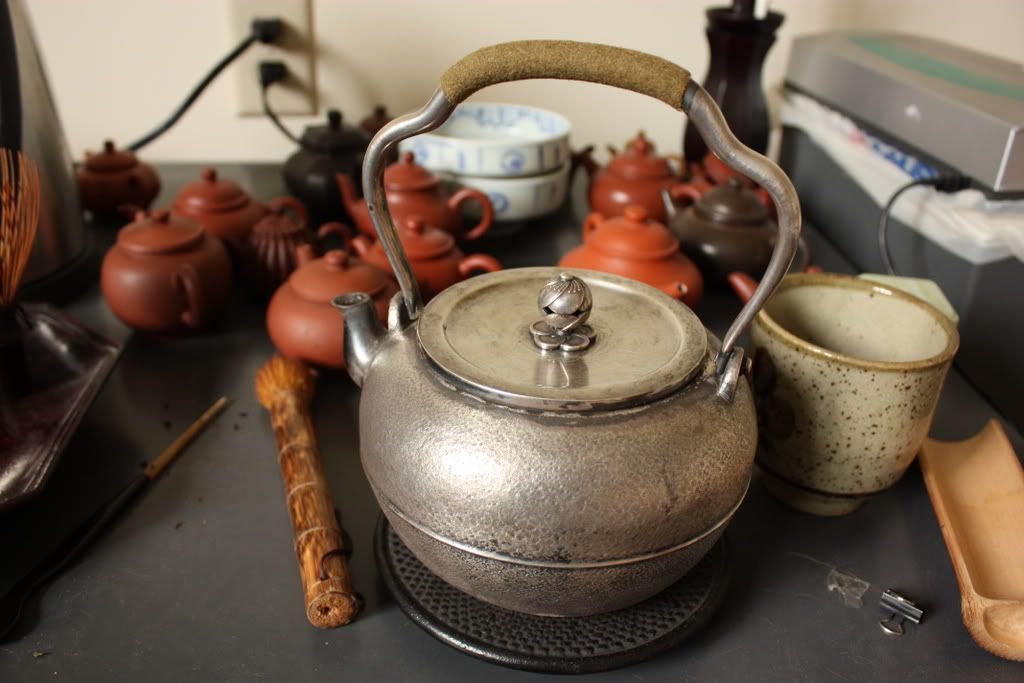
And I noticed, after drinking one bowl of that stuff, that my heart started pumping a little faster, my mind got a little clearer, and I was having a bit of a caffeine buzz. Of course, it probably was more obvious than usual because it was late in the day for my first dose of the stuff (5pm) so it might have accentuated the effects, but regardless, it made me wonder if that’s why so many people like drinking matcha. A friend recently told me that although she is a die-hard coca-cola drinker, she recently took a liking to a new kind of Pepsi. She couldn’t figure out why, until she noticed that Pepsi Max includes, among other things, a double dose of caffeine compared to regular Pepsi. Small wonder that she likes it more.
So, if in need of a caffeine kick, drink lots of matcha.
Categories: Old Xanga posts · Teas
Tagged: green tea, silver, teaware
Interesting.... would 250C in my oven work?